tires VOLVO XC70 2013 Owner´s Manual
[x] Cancel search | Manufacturer: VOLVO, Model Year: 2013, Model line: XC70, Model: VOLVO XC70 2013Pages: 382, PDF Size: 6.78 MB
Page 318 of 382
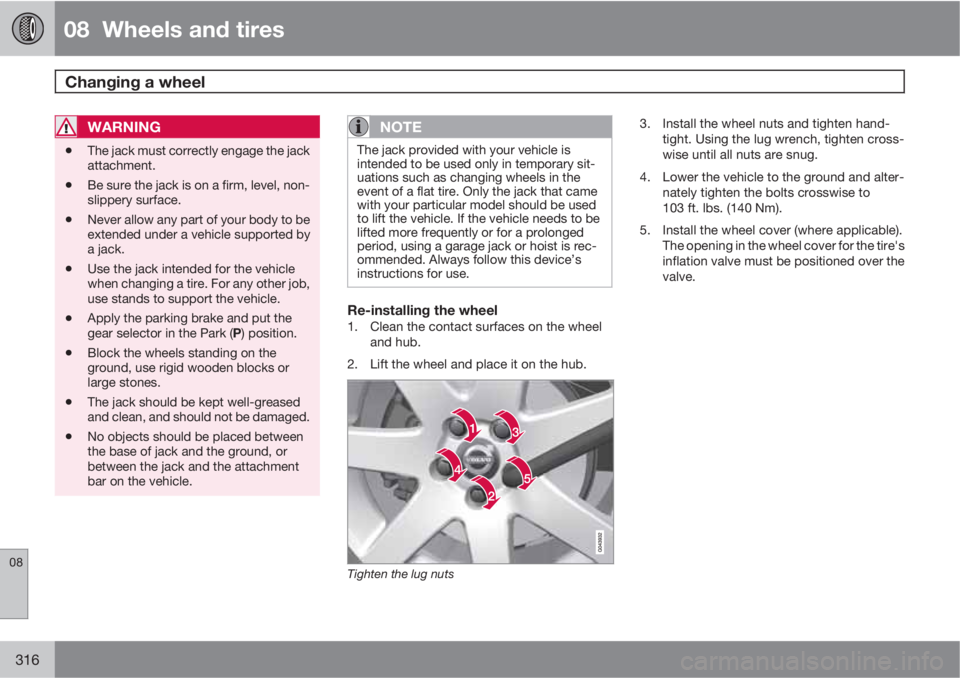
08 Wheels and tires
Changing a wheel
08
316
WARNING
•The jack must correctly engage the jack
attachment.
•Be sure the jack is on a firm, level, non-
slippery surface.
•Never allow any part of your body to be
extended under a vehicle supported by
a jack.
•Use the jack intended for the vehicle
when changing a tire. For any other job,
use stands to support the vehicle.
•Apply the parking brake and put the
gear selector in the Park (P) position.
•Block the wheels standing on the
ground, use rigid wooden blocks or
large stones.
•The jack should be kept well-greased
and clean, and should not be damaged.
•No objects should be placed between
the base of jack and the ground, or
between the jack and the attachment
bar on the vehicle.
NOTE
The jack provided with your vehicle is
intended to be used only in temporary sit-
uations such as changing wheels in the
event of a flat tire. Only the jack that came
with your particular model should be used
to lift the vehicle. If the vehicle needs to be
lifted more frequently or for a prolonged
period, using a garage jack or hoist is rec-
ommended. Always follow this device’s
instructions for use.
Re-installing the wheel1. Clean the contact surfaces on the wheel
and hub.
2. Lift the wheel and place it on the hub.
Tighten the lug nuts
3. Install the wheel nuts and tighten hand-
tight. Using the lug wrench, tighten cross-
wise until all nuts are snug.
4. Lower the vehicle to the ground and alter-
nately tighten the bolts crosswise to
103 ft. lbs. (140 Nm).
5. Install the wheel cover (where applicable).
The opening in the wheel cover for the tire's
inflation valve must be positioned over the
valve.
Page 319 of 382
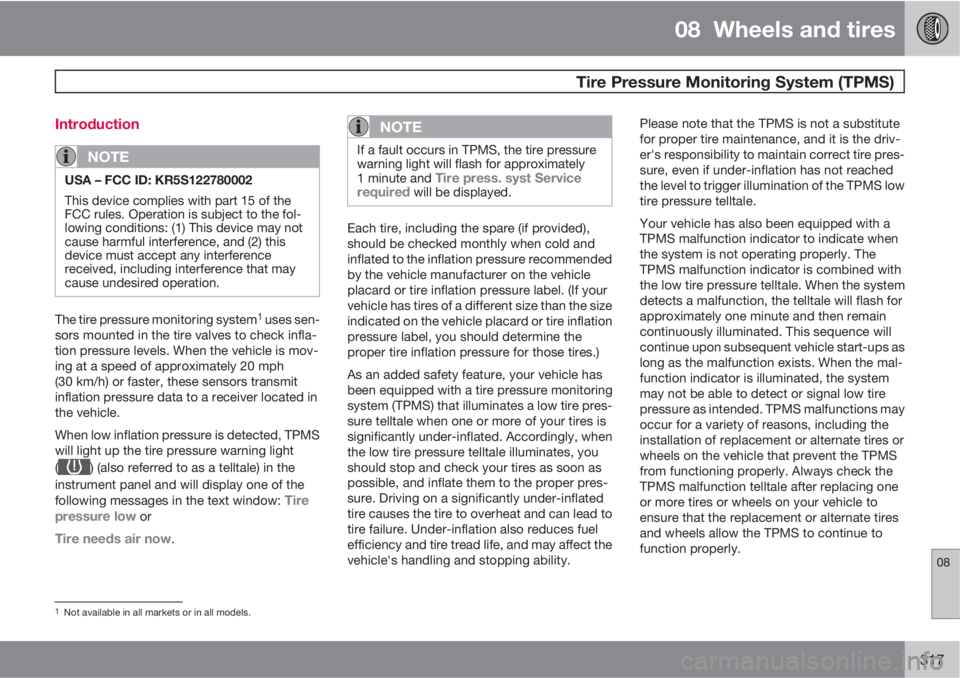
08 Wheels and tires
Tire Pressure Monitoring System (TPMS)
08
317 Introduction
NOTE
USA – FCC ID: KR5S122780002
This device complies with part 15 of the
FCC rules. Operation is subject to the fol-
lowing conditions: (1) This device may not
cause harmful interference, and (2) this
device must accept any interference
received, including interference that may
cause undesired operation.
The tire pressure monitoring system1 uses sen-
sors mounted in the tire valves to check infla-
tion pressure levels. When the vehicle is mov-
ing at a speed of approximately 20 mph
(30 km/h) or faster, these sensors transmit
inflation pressure data to a receiver located in
the vehicle.
When low inflation pressure is detected, TPMS
will light up the tire pressure warning light
(
) (also referred to as a telltale) in the
instrument panel and will display one of the
following messages in the text window:
Tire
pressure low or
Tire needs air now.
NOTE
If a fault occurs in TPMS, the tire pressure
warning light will flash for approximately
1 minute and
Tire press. syst Service
required will be displayed.
Each tire, including the spare (if provided),
should be checked monthly when cold and
inflated to the inflation pressure recommended
by the vehicle manufacturer on the vehicle
placard or tire inflation pressure label. (If your
vehicle has tires of a different size than the size
indicated on the vehicle placard or tire inflation
pressure label, you should determine the
proper tire inflation pressure for those tires.)
As an added safety feature, your vehicle has
been equipped with a tire pressure monitoring
system (TPMS) that illuminates a low tire pres-
sure telltale when one or more of your tires is
significantly under-inflated. Accordingly, when
the low tire pressure telltale illuminates, you
should stop and check your tires as soon as
possible, and inflate them to the proper pres-
sure. Driving on a significantly under-inflated
tire causes the tire to overheat and can lead to
tire failure. Under-inflation also reduces fuel
efficiency and tire tread life, and may affect the
vehicle's handling and stopping ability.Please note that the TPMS is not a substitute
for proper tire maintenance, and it is the driv-
er's responsibility to maintain correct tire pres-
sure, even if under-inflation has not reached
the level to trigger illumination of the TPMS low
tire pressure telltale.
Your vehicle has also been equipped with a
TPMS malfunction indicator to indicate when
the system is not operating properly. The
TPMS malfunction indicator is combined with
the low tire pressure telltale. When the system
detects a malfunction, the telltale will flash for
approximately one minute and then remain
continuously illuminated. This sequence will
continue upon subsequent vehicle start-ups as
long as the malfunction exists. When the mal-
function indicator is illuminated, the system
may not be able to detect or signal low tire
pressure as intended. TPMS malfunctions may
occur for a variety of reasons, including the
installation of replacement or alternate tires or
wheels on the vehicle that prevent the TPMS
from functioning properly. Always check the
TPMS malfunction telltale after replacing one
or more tires or wheels on your vehicle to
ensure that the replacement or alternate tires
and wheels allow the TPMS to continue to
function properly.
1Not available in all markets or in all models.
Page 320 of 382
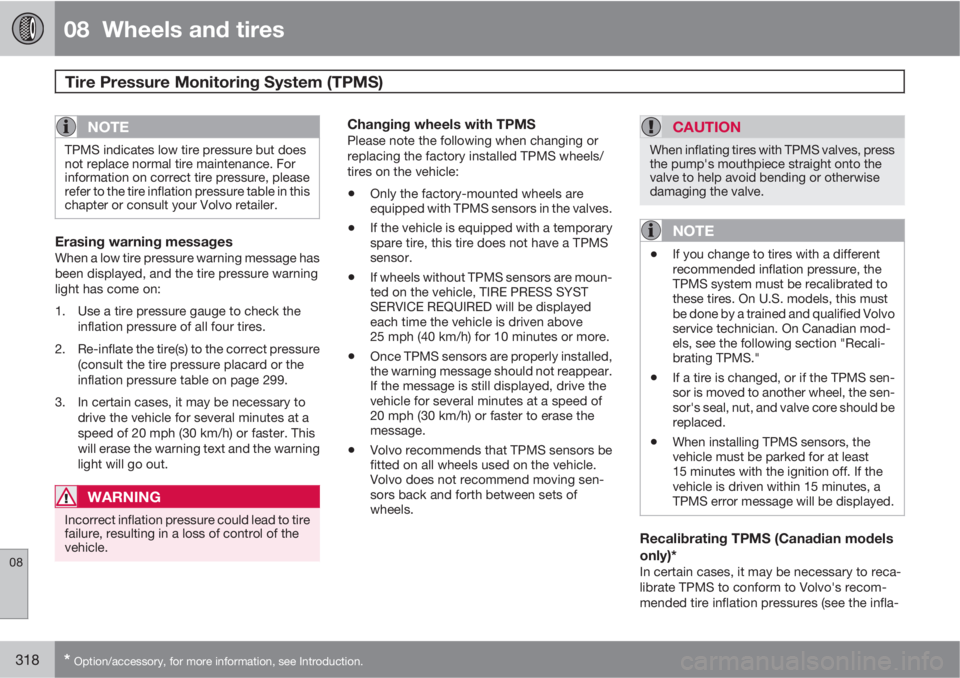
08 Wheels and tires
Tire Pressure Monitoring System (TPMS)
08
318* Option/accessory, for more information, see Introduction.
NOTE
TPMS indicates low tire pressure but does
not replace normal tire maintenance. For
information on correct tire pressure, please
refer to the tire inflation pressure table in this
chapter or consult your Volvo retailer.
Erasing warning messagesWhen a low tire pressure warning message has
been displayed, and the tire pressure warning
light has come on:
1. Use a tire pressure gauge to check the
inflation pressure of all four tires.
2. Re-inflate the tire(s) to the correct pressure
(consult the tire pressure placard or the
inflation pressure table on page 299.
3. In certain cases, it may be necessary to
drive the vehicle for several minutes at a
speed of 20 mph (30 km/h) or faster. This
will erase the warning text and the warning
light will go out.
WARNING
Incorrect inflation pressure could lead to tire
failure, resulting in a loss of control of the
vehicle.
Changing wheels with TPMSPlease note the following when changing or
replacing the factory installed TPMS wheels/
tires on the vehicle:
•Only the factory-mounted wheels are
equipped with TPMS sensors in the valves.
•If the vehicle is equipped with a temporary
spare tire, this tire does not have a TPMS
sensor.
•If wheels without TPMS sensors are moun-
ted on the vehicle, TIRE PRESS SYST
SERVICE REQUIRED will be displayed
each time the vehicle is driven above
25 mph (40 km/h) for 10 minutes or more.
•Once TPMS sensors are properly installed,
the warning message should not reappear.
If the message is still displayed, drive the
vehicle for several minutes at a speed of
20 mph (30 km/h) or faster to erase the
message.
•Volvo recommends that TPMS sensors be
fitted on all wheels used on the vehicle.
Volvo does not recommend moving sen-
sors back and forth between sets of
wheels.
CAUTION
When inflating tires with TPMS valves, press
the pump's mouthpiece straight onto the
valve to help avoid bending or otherwise
damaging the valve.
NOTE
•If you change to tires with a different
recommended inflation pressure, the
TPMS system must be recalibrated to
these tires. On U.S. models, this must
be done by a trained and qualified Volvo
service technician. On Canadian mod-
els, see the following section "Recali-
brating TPMS."
•If a tire is changed, or if the TPMS sen-
sor is moved to another wheel, the sen-
sor's seal, nut, and valve core should be
replaced.
•When installing TPMS sensors, the
vehicle must be parked for at least
15 minutes with the ignition off. If the
vehicle is driven within 15 minutes, a
TPMS error message will be displayed.
Recalibrating TPMS (Canadian models
only)*
In certain cases, it may be necessary to reca-
librate TPMS to conform to Volvo's recom-
mended tire inflation pressures (see the infla-
Page 321 of 382
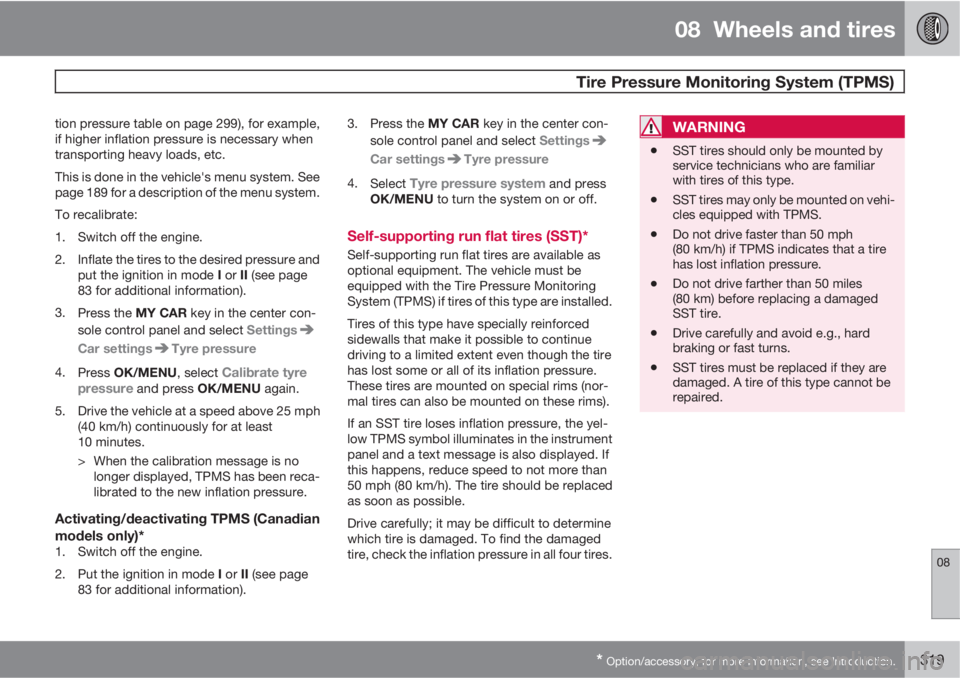
08 Wheels and tires
Tire Pressure Monitoring System (TPMS)
08
* Option/accessory, for more information, see Introduction.319
tion pressure table on page 299), for example,
if higher inflation pressure is necessary when
transporting heavy loads, etc.
This is done in the vehicle's menu system. See
page 189 for a description of the menu system.
To recalibrate:
1. Switch off the engine.
2. Inflate the tires to the desired pressure and
put the ignition in mode I or II (see page
83 for additional information).
3.
Press the MY CAR key in the center con-
sole control panel and select Settings
Car settingsTyre pressure
4.
Press OK/MENU, select
Calibrate tyre
pressure and press OK/MENU again.
5. Drive the vehicle at a speed above 25 mph
(40 km/h) continuously for at least
10 minutes.
> When the calibration message is no
longer displayed, TPMS has been reca-
librated to the new inflation pressure.
Activating/deactivating TPMS (Canadian
models only)*
1. Switch off the engine.
2.
Put the ignition in mode I or II (see page
83 for additional information).3.
Press the MY CAR key in the center con-
sole control panel and select Settings
Car settingsTyre pressure
4.
Select
Tyre pressure system and press
OK/MENU to turn the system on or off.
Self-supporting run flat tires (SST)*
Self-supporting run flat tires are available as
optional equipment. The vehicle must be
equipped with the Tire Pressure Monitoring
System (TPMS) if tires of this type are installed.
Tires of this type have specially reinforced
sidewalls that make it possible to continue
driving to a limited extent even though the tire
has lost some or all of its inflation pressure.
These tires are mounted on special rims (nor-
mal tires can also be mounted on these rims).
If an SST tire loses inflation pressure, the yel-
low TPMS symbol illuminates in the instrument
panel and a text message is also displayed. If
this happens, reduce speed to not more than
50 mph (80 km/h). The tire should be replaced
as soon as possible.
Drive carefully; it may be difficult to determine
which tire is damaged. To find the damaged
tire, check the inflation pressure in all four tires.
WARNING
•SST tires should only be mounted by
service technicians who are familiar
with tires of this type.
•SST tires may only be mounted on vehi-
cles equipped with TPMS.
•Do not drive faster than 50 mph
(80 km/h) if TPMS indicates that a tire
has lost inflation pressure.
•Do not drive farther than 50 miles
(80 km) before replacing a damaged
SST tire.
•Drive carefully and avoid e.g., hard
braking or fast turns.
•SST tires must be replaced if they are
damaged. A tire of this type cannot be
repaired.
Page 325 of 382

09 Maintenance and specifications
Maintaining your car09
323 Owner maintenance
Periodic maintenance requirements and inter-
vals are described in your vehicle's Warranty
and Service Records Information booklet.
The following points can be carried out
between the normally scheduled maintenance
services.
Each time the car is refueled:
•Check the engine oil level.
•Clean the windshield, windshield wipers,
headlights, and taillights.
Monthly:
•Check cold tire pressure in all tires. Inspect
the tires for wear.
•Check that engine coolant and other fluid
levels are between the indicated "min" and
"max" markings.
•Clean interior glass surfaces with a glass
cleaner and soft paper towels.
•Wipe driver information displays with a soft
cloth.
•Visually inspect battery terminals for cor-
rosion. Corrosion may indicate a loose ter-
minal connector, or a battery near the end
of its useful service life. Consult your Volvo
retailer for additional information.
As needed:Wash the car, including the undercarriage, to
reduce wear that can be caused by a buildup
of dirt, and corrosion that can be caused by salt
residues.
Clean leaves and twigs from air intake vents at
the base of the windshield, and from other pla-
ces where they may collect.
NOTE
Complete service information for qualified
technicians is available online for purchase
or subscription at www.volvotechinfo.com.
Hoisting the vehicle
If a garage jack is used to lift the vehicle, the
two jack attachments points should be used.They are specially reinforced to bear the weight
of the vehicle. A garage jack can also be placed
under the front of the engine support frame.
Take care not to damage the splash guard
under the engine. Ensure that the jack is posi-
tioned so that the vehicle cannot slide off it.
Always use axle stands or similar structures.
If a two-post hoist is used to lift the vehicle, the
front and rear lift arm pads should be centered
under the reinforced lift plates on the inboard
edge of the sill rail (see illustration).
Emission inspection readiness
What is an Onboard Diagnostic System
(OBD II)?
OBD II is part of your vehicle's computerized
engine management system. It stores diagnos-
tic information about your vehicle's emission
controls. It can light the Check Engine light
(MIL) if it detects an emission control "fault." A
"fault" is a component or system that is not
performing within an expected range. A fault
may be permanent or temporary. OBD II will
store a message about any fault.
How do states use OBD II for emission
inspections?
Many states connect a computer directly to a
vehicle's OBD II system. The inspector can
then read "faults." In some states, this type of
Page 361 of 382

10 Specifications
Label information
10
359 List of labels
Model
plate. Vehicle Identification Number (VIN).
Codes for color and upholstery, etc. The
model plate is located on the rear side of
the B-pillar (the pillar between the front and
rear passenger doors) and the rear pas-
senger's door must be open in order to see
it.
Federal Motor Vehicle Safety Standards
(FMVSS) specifications (USA) and Min-
istry of Transport (CMVSS) standards
(Canada). Your Volvo is designed to meet
all applicable safety standards, as evi-
denced by the certification label on the
driver's side B-pillar (the structural mem-
ber at the side of the vehicle, at the rear of
the driver's door opening). For further infor-
mation regarding these regulations, please
consult your Volvo retailer.
Tire inflation
pressures. This label indicates the correct
inflation pressures for the tires that were on
the vehicle when it left the factory. Cana-
dian models have the upper decal; U.S.
models have the lower one.
Vehicle Identification Number
(VIN). The VIN plate is located on the top
left surface of the dashboard. The Vehicle
Identification Number (VIN) should always
be quoted in all correspondence concern-
ing your vehicle with the retailer and when
ordering parts.
Vehicle Emission Control Information.
Your Volvo is designed to meet all appli-
cable emission standards, as evidenced by
the certification label on the underside of
the hood. For further information regarding
these regulations, please consult your
Volvo retailer.
Page 374 of 382
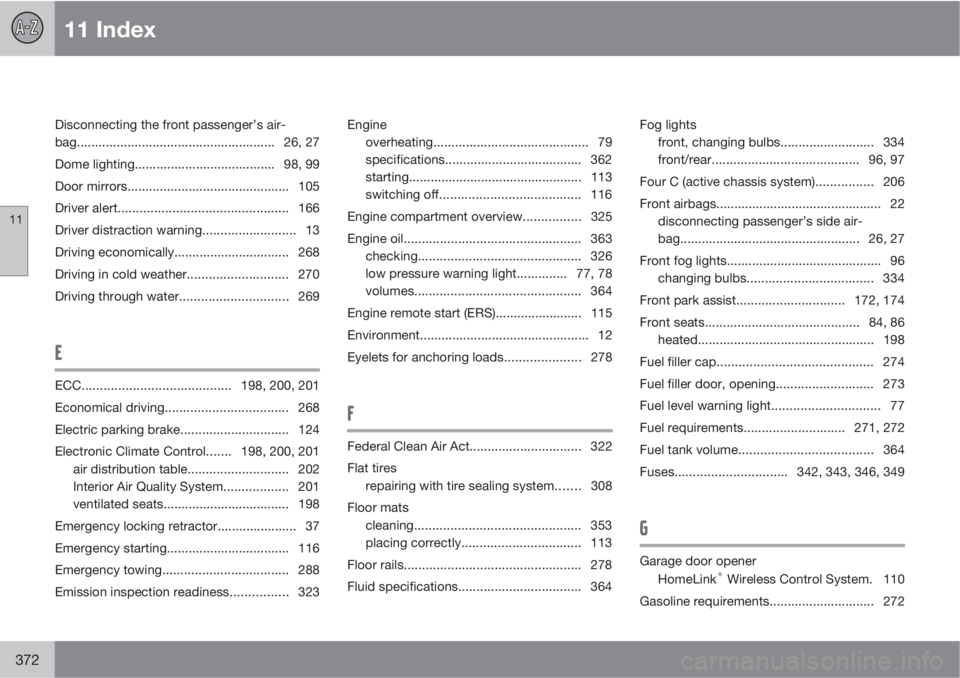
11 Index
11
372
Disconnecting the front passenger’s air-
bag....................................................... 26, 27
Dome lighting....................................... 98, 99
Door mirrors............................................. 105
Driver alert............................................... 166
Driver distraction warning.......................... 13
Driving economically................................ 268
Driving in cold weather............................ 270
Driving through water..............................269
E
ECC.........................................198, 200, 201
Economical driving.................................. 268
Electric parking brake.............................. 124
Electronic Climate Control.......198, 200, 201
air distribution table............................ 202
Interior Air Quality System.................. 201
ventilated seats................................... 198
Emergency locking retractor...................... 37
Emergency starting.................................. 116
Emergency towing................................... 288
Emission inspection readiness................ 323Engine
overheating........................................... 79
specifications...................................... 362
starting................................................ 113
switching off....................................... 116
Engine compartment overview................325
Engine oil................................................. 363
checking............................................. 326
low pressure warning light.............. 77, 78
volumes.............................................. 364
Engine remote start (ERS)........................ 115
Environment............................................... 12
Eyelets for anchoring loads..................... 278
F
Federal Clean Air Act............................... 322
Flat tires
repairing with tire sealing system....... 308
Floor mats
cleaning.............................................. 353
placing correctly................................. 113
Floor rails................................................. 278
Fluid specifications.................................. 364Fog lights
front, changing bulbs.......................... 334
front/rear......................................... 96, 97
Four C (active chassis system)................206
Front airbags.............................................. 22
disconnecting passenger’s side air-
bag.................................................. 26, 27
Front fog lights........................................... 96
changing bulbs................................... 334
Front park assist.............................. 172, 174
Front seats...........................................84, 86
heated................................................. 198
Fuel filler cap........................................... 274
Fuel filler door, opening........................... 273
Fuel level warning light.............................. 77
Fuel requirements............................ 271, 272
Fuel tank volume.....................................364
Fuses............................... 342, 343, 346, 349
G
Garage door opener
HomeLink® Wireless Control System. 110
Gasoline requirements............................. 272
Page 378 of 382
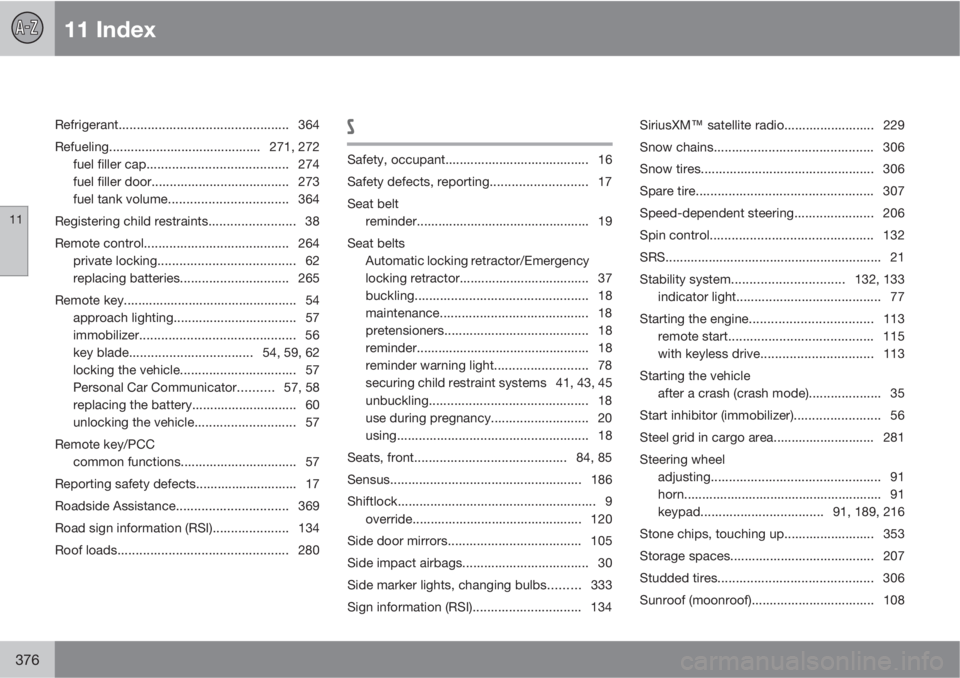
11 Index
11
376
Refrigerant............................................... 364
Refueling..........................................271, 272
fuel filler cap....................................... 274
fuel filler door...................................... 273
fuel tank volume.................................364
Registering child restraints........................ 38
Remote control........................................ 264
private locking...................................... 62
replacing batteries.............................. 265
Remote key................................................ 54
approach lighting.................................. 57
immobilizer........................................... 56
key blade..................................54, 59, 62
locking the vehicle................................ 57
Personal Car Communicator..........57, 58
replacing the battery............................. 60
unlocking the vehicle............................ 57
Remote key/PCC
common functions................................ 57
Reporting safety defects............................ 17
Roadside Assistance............................... 369
Road sign information (RSI)..................... 134
Roof loads............................................... 280S
Safety, occupant........................................ 16
Safety defects, reporting........................... 17
Seat belt
reminder................................................ 19
Seat belts
Automatic locking retractor/Emergency
locking retractor.................................... 37
buckling................................................ 18
maintenance......................................... 18
pretensioners........................................ 18
reminder................................................ 18
reminder warning light.......................... 78
securing child restraint systems 41, 43, 45
unbuckling............................................ 18
use during pregnancy........................... 20
using.....................................................18
Seats, front.......................................... 84, 85
Sensus.....................................................186
Shiftlock....................................................... 9
override............................................... 120
Side door mirrors..................................... 105
Side impact airbags................................... 30
Side marker lights, changing bulbs......... 333
Sign information (RSI).............................. 134SiriusXM
E satellite radio......................... 229
Snow chains............................................ 306
Snow tires................................................ 306
Spare tire................................................. 307
Speed-dependent steering...................... 206
Spin control............................................. 132
SRS............................................................ 21
Stability system...............................132, 133
indicator light........................................ 77
Starting the engine..................................113
remote start........................................ 115
with keyless drive...............................113
Starting the vehicle
after a crash (crash mode)....................35
Start inhibitor (immobilizer)........................ 56
Steel grid in cargo area............................ 281
Steering wheel
adjusting............................................... 91
horn....................................................... 91
keypad.................................. 91, 189, 216
Stone chips, touching up......................... 353
Storage spaces........................................ 207
Studded tires........................................... 306
Sunroof (moonroof).................................. 108
Page 379 of 382
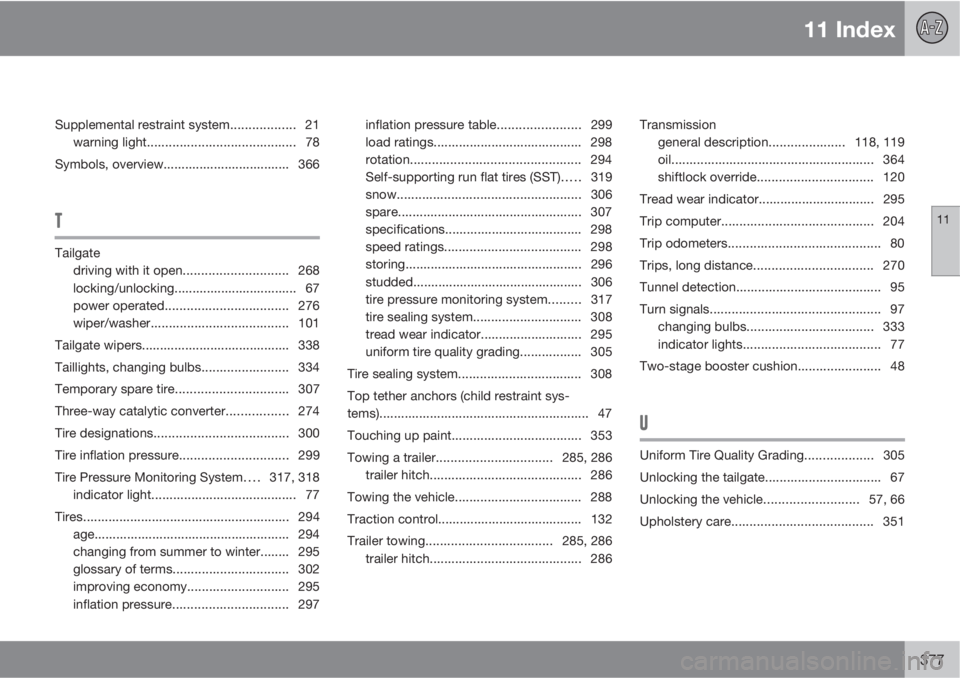
11 Index
11
377
Supplemental restraint system.................. 21
warning light......................................... 78
Symbols, overview................................... 366
T
Tailgate
driving with it open.............................268
locking/unlocking.................................. 67
power operated.................................. 276
wiper/washer...................................... 101
Tailgate wipers......................................... 338
Taillights, changing bulbs........................ 334
Temporary spare tire............................... 307
Three-way catalytic converter................. 274
Tire designations.....................................300
Tire inflation pressure..............................299
Tire Pressure Monitoring System....317, 318
indicator light........................................ 77
Tires.........................................................294
age...................................................... 294
changing from summer to winter........ 295
glossary of terms................................ 302
improving economy............................ 295
inflation pressure................................ 297inflation pressure table.......................299
load ratings......................................... 298
rotation............................................... 294
Self-supporting run flat tires (SST)..... 319
snow...................................................306
spare................................................... 307
specifications...................................... 298
speed ratings...................................... 298
storing................................................. 296
studded............................................... 306
tire pressure monitoring system......... 317
tire sealing system.............................. 308
tread wear indicator............................ 295
uniform tire quality grading................. 305
Tire sealing system.................................. 308
Top tether anchors (child restraint sys-
tems).......................................................... 47
Touching up paint.................................... 353
Towing a trailer................................285, 286
trailer hitch.......................................... 286
Towing the vehicle................................... 288
Traction control........................................ 132
Trailer towing...................................285, 286
trailer hitch.......................................... 286Transmission
general description.....................118, 119
oil........................................................ 364
shiftlock override................................ 120
Tread wear indicator................................ 295
Trip computer.......................................... 204
Trip odometers.......................................... 80
Trips, long distance................................. 270
Tunnel detection........................................ 95
Turn signals............................................... 97
changing bulbs................................... 333
indicator lights...................................... 77
Two-stage booster cushion....................... 48
U
Uniform Tire Quality Grading...................305
Unlocking the tailgate................................ 67
Unlocking the vehicle..........................57, 66
Upholstery care....................................... 351